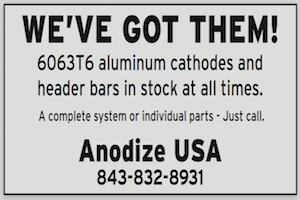
Curated with aloha by
Ted Mooney, P.E. RET

The authoritative public forum
for Metal Finishing 1989-2025

-----
Chemical resistance of nickel plating
Q. Hello,
I am trying to accomplish chemical resistance (OH resistance like IPA) with nickel plating.
Any recommendation on concentration, time, temp, pH?
I am coating SS and aluminum.
- st louis, Missouri
July 6, 2022
A. Hi S. At the risk of slight over simplification, "nickel is nickel" and the chemical resistance of nickel plating is not highly dependent upon those factors. The single most important thing is that the plating is thick enough, and applied correctly, onto a properly prepared substrate. Because the real issue is that nickel is far less active than aluminum and will force the aluminum to corrode rapidly if the plating exhibits any porosity or pinholes. If your substrate is highly polished a quite thin layer of nickel may suffice; if it is relatively rough, a lot more nickel will be required to guarantee freedom from those defects.
If you need substantial chemical resistance, electroless nickel plating (a nickel-phosphorous deposit) is quite a bit more expensive than electrolytic nickel but is much more corrosion resistant.
Luck & Regards,

Ted Mooney, P.E. RET
Striving to live Aloha
finishing.com - Pine Beach, New Jersey
Q. Thank you for the reply!
My parts are highly polished with small nozzles in them, my plan is to use electroless nickel plating.
Any recommendation on the bath chemical %'s? What is the best acid to use? pH 3-4?, Temp.?
- St louis
July 18, 2022
A. Hi again. If the parts are highly polished you can probably get porosity-free, pore-free electroless nickel at a thickness of just a couple of ten-thousandths of an inch.
But this is the 2nd time you've asked about concentration, pH, and temperature of the plating bath and I'm thinking that it's possible that you may have a misunderstanding of what is involved in plating. Firstly, you don't make an electroless nickel plating solution from raw chemicals; you buy it from a supplier of electroless nickel processes, and they give you a technical data sheet instructing you how to operate it, including concentration, pH, and temperature. Secondly, the plating step per se is but one step in a multi-step process. First you non-etch clean the aluminum parts, then you etch (or don't etch) them, then you de-smut/de-oxidize, then you zincate, all before the electroless nickel step, and with generous rinsing between each stage.
The stainless parts need, as a minimum, cleaning, acid activation, and Wood's Nickel Strike before electroless nickel plating.
Luck & Regards,

Ted Mooney, P.E. RET
Striving to live Aloha
finishing.com - Pine Beach, New Jersey
finishing.com is made possible by ...

Q, A, or Comment on THIS thread -or- Start a NEW Thread